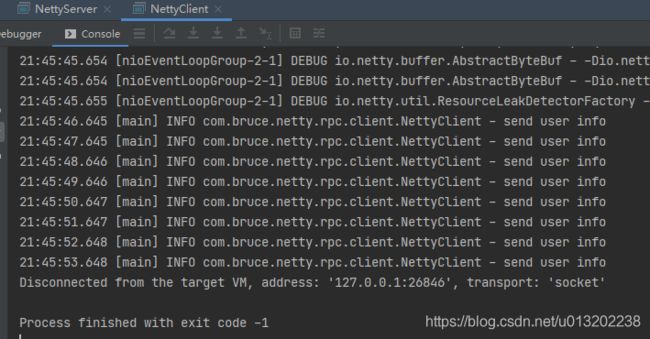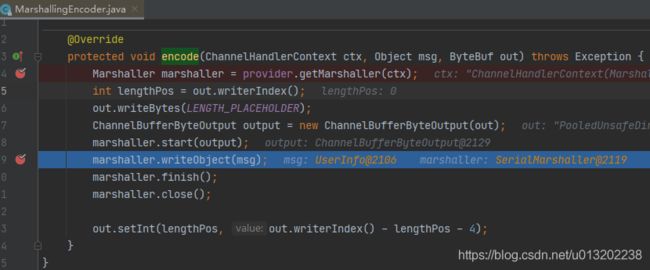netty客户端发送数据时异常被隐藏
问题描述
最近需要用netty实现一个中间件通信,开始为了先快速把客户端和服务端通信的demo完成,只是采用了字符串的编解码方式(StringEncoder,StringDecoder)。客户端和服务端可以正常互发数据,一切运行正常。
但是字符串的编解码并不适合业务实体类的传输,为了快速实现实体类传输,所以决定采用jboss-marshalling-serial序列化方式先完成demo,但是在客户端发送数据时,服务端却无法收到数据,客户端控制台也没有任何异常信息。
先看整个demo实现代码,再查找问题原因。(先提前说明,示例代码是完全正确无逻辑bug的)
pom依赖
<dependencies>
<dependency>
<groupId>org.springframework.bootgroupId>
<artifactId>spring-boot-starterartifactId>
dependency>
<dependency>
<groupId>io.nettygroupId>
<artifactId>netty-allartifactId>
<version>4.1.56.Finalversion>
dependency>
<dependency>
<groupId>org.jboss.marshallinggroupId>
<artifactId>jboss-marshalling-serialartifactId>
<version>2.0.10.Finalversion>
dependency>
dependencies>
jboss-marshalling-serial序列化工具类
- netty提供的Marshalling编解码器采用消息头和消息体的方式
- JBoss Marshalling是一个Java对象序列化包,对jdk默认的序列化框架进行优化,但又保持跟Serializable接口的兼容,同时增加了一些可调用的参数和附加的特性
- 经过测试发现序列化后的流较protostuff,MessagePack还是比较大的,
- 序列化和反序列化的类必须是同一个类,否则抛出异常: io.netty.handler.codec.DecoderException: java.lang.ClassNotFoundException: com.bruce.netty.rpc.entity.UserInfo
public final class MarshallingCodeFactory {
private static final InternalLogger log = InternalLoggerFactory.getInstance(MarshallingCodeFactory.class);
/** 创建Jboss marshalling 解码器 */
public static MyMarshallingDecoder buildMarshallingDecoder() {
//参数serial表示创建的是Java序列化工厂对象,由jboss-marshalling-serial提供
MarshallerFactory factory = Marshalling.getProvidedMarshallerFactory("serial");
MarshallingConfiguration configuration = new MarshallingConfiguration();
configuration.setVersion(5);
DefaultUnmarshallerProvider provider = new DefaultUnmarshallerProvider(factory, configuration);
return new MyMarshallingDecoder(provider, 1024);
}
/** 创建Jboss marshalling 编码器 */
public static MarshallingEncoder buildMarshallingEncoder() {
MarshallerFactory factory = Marshalling.getProvidedMarshallerFactory("serial");
MarshallingConfiguration configuration = new MarshallingConfiguration();
configuration.setVersion(5);
DefaultMarshallerProvider provider = new DefaultMarshallerProvider(factory, configuration);
return new MarshallingEncoder(provider);
}
public static class MyMarshallingDecoder extends MarshallingDecoder {
public MyMarshallingDecoder(UnmarshallerProvider provider, int maxObjectSize) {
super(provider, maxObjectSize);
}
@Override
protected Object decode(ChannelHandlerContext ctx, ByteBuf in) throws Exception {
log.info("读取数据长度:{}", in.readableBytes());
return super.decode(ctx, in);
}
}
}
服务端代码实现
服务端业务处理器:(真实场景中不要在io线程执行耗时业务逻辑处理)
@ChannelHandler.Sharable
public class SimpleServerHandler extends ChannelInboundHandlerAdapter {
private static final InternalLogger log = InternalLoggerFactory.getInstance(SimpleServerHandler.class);
@Override
public void handlerAdded(ChannelHandlerContext ctx) throws Exception {
log.info("handlerAdded" + this.hashCode());
}
@Override
public void channelRead(ChannelHandlerContext ctx, Object msg) throws Exception {
log.info("server channelRead:{}", msg);
ctx.channel().writeAndFlush("hello netty");
}
@Override
public void exceptionCaught(ChannelHandlerContext ctx, Throwable cause) throws Exception {
if (cause instanceof java.io.IOException) {
log.warn("client close");
} else {
cause.printStackTrace();
}
}
}
服务端启动类
public class NettyServer {
private static final InternalLogger log = InternalLoggerFactory.getInstance(NettyServer.class);
public static void main(String[] args) throws Exception {
EventLoopGroup acceptGroup = new NioEventLoopGroup();
EventLoopGroup workerGroup = new NioEventLoopGroup();
Class<? extends ServerSocketChannel> serverSocketChannelClass = NioServerSocketChannel.class;
ServerBootstrap bootstrap = new ServerBootstrap();
bootstrap.group(acceptGroup, workerGroup)
.channel(serverSocketChannelClass)
.option(ChannelOption.SO_BACKLOG, 128)
.option(ChannelOption.SO_REUSEADDR, true)
.childOption(ChannelOption.SO_KEEPALIVE, false) //默认为false
.handler(new LoggingHandler())
.childHandler(new CustomCodecChannelInitializer());
try {
//sync() 将异步变为同步,绑定到8088端口
ChannelFuture channelFuture = bootstrap.bind(8088).sync();
log.info("server 启动成功");
} catch (Exception e) {
e.printStackTrace();
}
Thread serverShutdown = new Thread(() -> {
log.info("执行jvm ShutdownHook, server shutdown");
acceptGroup.shutdownGracefully();
workerGroup.shutdownGracefully();
});
//注册jvm ShutdownHook,jvm退出之前关闭服务资源
Runtime.getRuntime().addShutdownHook(serverShutdown);
}
static class CustomCodecChannelInitializer extends ChannelInitializer<SocketChannel> {
@Override
protected void initChannel(SocketChannel ch) throws Exception {
ChannelPipeline pipeline = ch.pipeline();
pipeline.addLast(MarshallingCodeFactory.buildMarshallingDecoder());
pipeline.addLast(MarshallingCodeFactory.buildMarshallingEncoder());
pipeline.addLast(new SimpleServerHandler());
}
}
}
客户端代码实现
客户端业务处理器
public class SimpleClientHandler extends ChannelInboundHandlerAdapter {
private static final InternalLogger log = InternalLoggerFactory.getInstance(SimpleClientHandler.class);
@Override
public void channelRead(ChannelHandlerContext ctx, Object msg) throws Exception {
log.info("client receive:{}", msg);
}
@Override
public void exceptionCaught(ChannelHandlerContext ctx, Throwable cause) throws Exception {
cause.printStackTrace();
}
}
客户端启动类
public class NettyClient {
private static final InternalLogger log = InternalLoggerFactory.getInstance(NettyClient.class);
public static void main(String[] args) {
EventLoopGroup workerGroup = new NioEventLoopGroup();
Class<? extends SocketChannel> socketChannelClass = NioSocketChannel.class;
Bootstrap bootstrap = new Bootstrap();
bootstrap.group(workerGroup)
.channel(socketChannelClass)
.option(ChannelOption.TCP_NODELAY, true)
.option(ChannelOption.SO_KEEPALIVE, false)
.option(ChannelOption.CONNECT_TIMEOUT_MILLIS, 30000)
.handler(new CustomCodecChannelInitializer());
Channel clientChannel;
try {
ChannelFuture channelFuture = bootstrap.connect("127.0.0.1", 8088);
//同步等待连接建立成功, 这里示例代码, 可以认为是一定会连接成功
boolean b = channelFuture.awaitUninterruptibly(10, TimeUnit.SECONDS);
clientChannel = channelFuture.channel();
for (int i = 0; i < 10; i++) {
Thread.sleep(1000);
UserInfo userInfo = new UserInfo("bruce", 18);
log.info("send user info");
//连接成功后发送数据
send(clientChannel, userInfo);
}
//实际上这个地方会永远阻塞等待
clientChannel.closeFuture().sync();
} catch (InterruptedException e) {
e.printStackTrace();
} finally {
workerGroup.shutdownGracefully();
}
}
static void send(Channel channel, UserInfo data) {
//连接成功后发送数据
ChannelFuture channelFuture1 = channel.writeAndFlush(data);
}
static class CustomCodecChannelInitializer extends ChannelInitializer<SocketChannel> {
@Override
protected void initChannel(SocketChannel ch) throws Exception {
ChannelPipeline pipeline = ch.pipeline();
pipeline.addLast(MarshallingCodeFactory.buildMarshallingDecoder());
pipeline.addLast(MarshallingCodeFactory.buildMarshallingEncoder());
pipeline.addLast(new SimpleClientHandler());
}
}
}
实体类UserInfo,
public class UserInfo {
private String username;
private int age;
public UserInfo() {
}
public UserInfo(String username, int age) {
this.username = username;
this.age = age;
}
//getter / setter 省略
}
先启动服务端,再启动客户端可以在idea控制台发现:
服务端和客户端建立了连接,客户端在发送数据, 但 是 服 务 端 却 没 有 收 到 , 并 且 控 制 台 没 有 任 何 异 常 信 息 \color{#FF3030}{但是服务端却没有收到,并且控制台没有任何异常信息} 但是服务端却没有收到,并且控制台没有任何异常信息


既然没有异常,只能先在客户端断点,确认客户端是否正常,根据经验直接查看MarshallingEncoder的编码方法MarshallingEncoder#encode,debug执行先确认UserInfo对象有没有被正确序列化。

在执行到marshaller.writeObject(msg)时出现了异常。

继续跟进断点会进入catch中,显示java.io.NotSerializableException,(脑中出现一句话:我大意了,没有…)已经可以知道UserInfo类没有继承序列化接口java.io.Serializable而抛出异常。UserInfo只需要继承java.io.Serializable就可以正常向客户端发送数据。
但是为什么控制台没有抛出异常呢 !?
继续跟进断点NotSerializableException被包装在io.netty.handler.codec.EncoderException中抛出,序列化的buf也在finally中被释放。而EncoderException会被AbstractChannelHandlerContext#invokeWrite0方法的catch语句中被处理。
private void invokeWrite0(Object msg, ChannelPromise promise) {
try {
((ChannelOutboundHandler) handler()).write(this, msg, promise);
} catch (Throwable t) {
notifyOutboundHandlerException(t, promise);
}
}
private static void notifyOutboundHandlerException(Throwable cause, ChannelPromise promise) {
// Only log if the given promise is not of type VoidChannelPromise as tryFailure(...) is expected to return
// false.
PromiseNotificationUtil.tryFailure(promise, cause, promise instanceof VoidChannelPromise ? null : logger);
}
最终会执行到io.netty.util.concurrent.DefaultPromise#setValue0,主要目的就是为了记录这个异常信息,然后检查是否有GenericFutureListener监听这次发送请求的结果。如果有Listener则在nio线程中回调监听器方法。
private boolean setValue0(Object objResult) {
if (RESULT_UPDATER.compareAndSet(this, null, objResult) ||
RESULT_UPDATER.compareAndSet(this, UNCANCELLABLE, objResult)) {
if (checkNotifyWaiters()) {
notifyListeners();
}
return true;
}
return false;
}
private synchronized boolean checkNotifyWaiters() {
if (waiters > 0) {
notifyAll();
}
return listeners != null;
}
然而笔者的示例中并没有设置GenericFutureListener,checkNotifyWaiters方法返回的是false,不会执行notifyListeners();方法,所以整个异常被吞没。而Promise#tryFailure方法最终返回true。
再看方法io.netty.util.internal.PromiseNotificationUtil#tryFailure,虽然也是会处理Throwable,但是只在Promise#tryFailure返回false并且logger不为null时执行。所以这里也不会打印出日志。
public static void tryFailure(Promise<?> p, Throwable cause, InternalLogger logger) {
if (!p.tryFailure(cause) && logger != null) {
Throwable err = p.cause();
if (err == null) {
logger.warn("Failed to mark a promise as failure because it has succeeded already: {}", p, cause);
} else if (logger.isWarnEnabled()) {
logger.warn(
"Failed to mark a promise as failure because it has failed already: {}, unnotified cause: {}",
p, ThrowableUtil.stackTraceToString(err), cause);
}
}
}
如何打印出这些异常信息呢?
方案1 (异步处理)
在数据发送过后,给ChannelFuture添加监听器,用于监听此次发送的结果,当出现异常时,对异常进行处理。
static void send(Channel channel, UserInfo data) {
//连接成功后发送数据
ChannelFuture channelFuture1 = channel.writeAndFlush(data);
channelFuture1.addListener(new ChannelFutureListener() {
@Override
public void operationComplete(ChannelFuture future) throws Exception {
Throwable cause = future.cause();
if (cause != null) {
cause.printStackTrace();
}
}
});
}
方案2 (不推荐,根据业务决定)
在数据发送过后,同步等待发送结果,判断是否存在异常。
static void send(Channel channel, UserInfo data) {
//连接成功后发送数据
ChannelFuture channelFuture1 = channel.writeAndFlush(data);
while (!channelFuture1.isDone()) {
try {
//超时时间示例值,根据业务决定
boolean notTimeout = channelFuture1.await(50);
} catch (Exception e) {
log.warn(e.getMessage());
}
}
Throwable cause = channelFuture1.cause();
if (cause != null) {
cause.printStackTrace();
}
}
没有监听ChannelFuture,异常就被隐藏是否合理呢?
这个问题见仁见智,对笔者有点代码洁癖来说,这里至少是可有优化一下的,不至于让开发者耗费时间去查找丢失的异常信息。优化逻辑也简单,在io.netty.util.concurrent.DefaultPromise#setFailure0中,如果既没有listeners也没有await等待时,则打印异常信息。
修DefaultPromise改代码如下:
private boolean setFailure0(Throwable cause) {
if (listeners == null && waiters == 0) {
logger.error("cause:", cause);
}
return setValue0(new CauseHolder(checkNotNull(cause, "cause")));
}
请看pr: https://github.com/netty/netty/pull/10917
总结
这里只是通过编码时没有注意到的细节(实体类没有实现序列化接口),来分析为什么异常被吞及处理方案,可以通过异常栈快速定位问题,但如果想要没有异常,则只能根据异常做相应的修改了。同时可以让我们更加了解netty的实现细节。
最后还是建议通过channel发送数据后,对返回的ChannelFuture做是否存在异常判断以及处理,防止出现类似的情况。